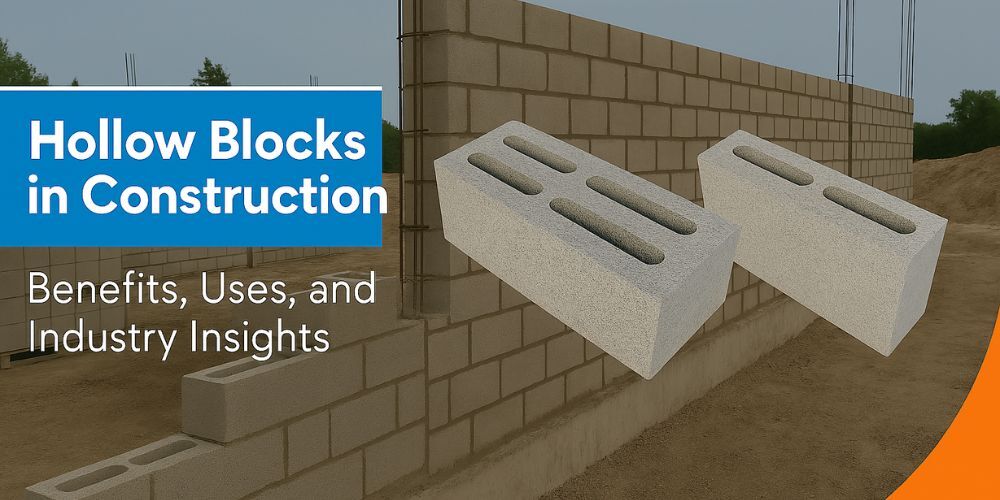Hollow blocks are a standard building material across multiple industries, valued for their structural capabilities and adaptability. They are rectangular masonry units made with cement, aggregates, and sand, featuring one or more hollow cores. These cores help reduce the weight of each unit while retaining the required strength for load-bearing and non-load-bearing applications. Their use spans residential housing, commercial buildings, industrial facilities, and public infrastructure
Understanding the Paving Challenge
The defining feature of hollow blocks is the internal cavity. This space can remain empty for insulation purposes or be filled with concrete and reinforcement steel for added load capacity. Their uniform dimensions allow for quicker wall construction and better alignment. Depending on the project, hollow blocks can be manufactured in various sizes strengths, and densities.
How Hollow Blocks Are Made
The production process ensures that each block meets precise technical standards:
- Material Selection and Mixing – Cement, aggregates, and sand are measured to match the required strength and durability, then mixed with water until uniform.
- Molding – The mix is placed into molds that form the block’s size and hollow cores.
- Compaction and Vibration – Machinery applies vibration and pressure to eliminate air pockets and ensure density.
- Curing – Blocks are kept in a controlled environment for proper hydration, improving strength and durability.
- Quality Testing – Each batch is checked for compressive strength, water absorption, and dimensional accuracy according to standards such as IS 2185 (Part I).
Benefits of Using Hollow Blocks
- Strong Yet Lightweight – Hollow blocks offer good load-bearing performance while reducing the weight on foundations, which can improve overall structural efficiency.
- Faster Construction – Larger size and consistent dimensions enable quicker wall assembly compared to smaller masonry units like clay bricks.
- Material and Cost Efficiency – Smooth surfaces reduce the amount of mortar and plaster needed. Hollow design also uses less concrete material per block compared to solid blocks.
- Thermal and Acoustic Properties – The air within the cavities helps reduce heat transfer and dampens sound, supporting comfortable indoor environments.
- Weather Resistance – Low water absorption protects against seepage, extending the lifespan of structures.
Industry-Specific Applications
- Housing Projects –In residential construction, hollow blocks are commonly used for both load-bearing and partition walls. Their size allows faster wall completion, and the thermal insulation helps keep indoor spaces comfortable. For multi-storey housing, reinforcing the hollow cores can improve strength without adding excessive weight.
- Commercial Buildings – Shopping complexes, office buildings, and retail spaces benefit from hollow blocks’ speed of construction and flexibility in design. Partition walls made with hollow blocks can be reconfigured or removed without affecting the main structural stability.
- Industrial Facilities – Factories, warehouses, and workshops require walls that can handle both environmental exposure and physical impact. Hollow blocks, when reinforced, provide durability for large spans while keeping construction efficient.
- Infrastructure and Public Works – In roads, drainage systems, and utility enclosures, hollow blocks are used for boundary walls, retaining walls, and protective barriers. They can be reinforced to manage heavy loads and withstand varying weather conditions.
How Hollow Blocks Improve Project Performance
- Reducing overall project time due to faster installation.
- Minimizing material waste through uniform sizing.
- Lowering the dead load on the structure allows for more efficient foundation design.
- Providing flexibility for both structural and non-structural applications.
- Offering a balance between performance and cost efficiency.
Choosing the Right Hollow Block
The right hollow block depends on the project’s needs:
- Strength Requirements – Measured in compressive strength, this determines load capacity.
- Block Dimensions – Width and height should match the wall thickness and design.
- Density – Higher density for strength, lower density for insulation.
- Water Absorption Rate – Lower rates are better for wet or humid environments.
- Fire Resistance – Essential for certain commercial or industrial uses.
- Reinforcement Compatibility – Ability to accommodate steel bars or concrete filling.
Sustainability Value
Hollow blocks contribute to sustainable building practices by using fewer raw materials, supporting recycled aggregates, and improving building insulation. Their durability reduces repair frequency, lowering long-term environmental impact.
Conclusion
Hollow blocks are a practical choice for a variety of construction needs, from residential housing to large-scale infrastructure. Their combination of strength, reduced weight, and adaptable design makes them suitable for both structural and non-structural applications. By understanding their benefits, production process, and industry-specific uses, professionals can make informed decisions that support both performance and efficiency in their projects.
FAQs on Hollow Blocks
Standard hollow blocks often measure 400 mm x 200 mm x 200 mm, though sizes may vary depending on regional standards and project requirements. Thinner blocks (e.g., 150 mm width) are used for partitions, while thicker ones (e.g., 230 mm width) are chosen for load-bearing walls.
Yes. Hollow blocks can be used for load-bearing walls, provided they meet the required compressive strength for the structure. For heavier loads or multi-storey buildings, the hollow cores can be filled with concrete and reinforced with steel bars.
Hollow blocks have internal cavities that reduce their weight and improve insulation. Solid blocks are heavier and offer higher density, but use more raw materials. The choice depends on the project’s structural and insulation needs.
Water absorption rates vary by manufacturing quality, but industry standards often require it to be less than 10% by weight. Low absorption reduces the risk of seepage and improves durability in wet conditions.
Yes. When manufactured and cured correctly, hollow blocks perform well in varied climates. In areas with high rainfall or humidity, selecting blocks with low water absorption and ensuring proper finishing can extend their service life.
Yes. Hollow blocks can be reinforced by filling the cores with concrete and placing steel bars inside. This increases load-bearing capacity for multi-storey buildings and heavy structures.

